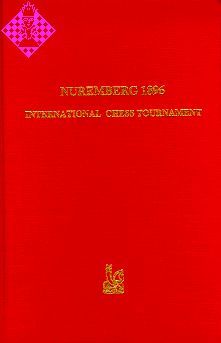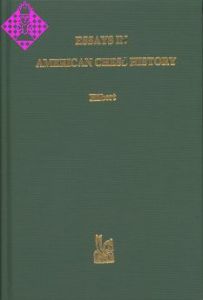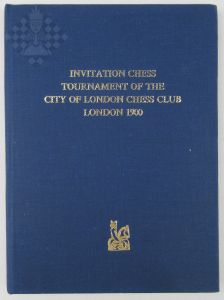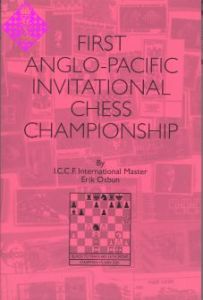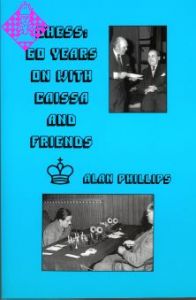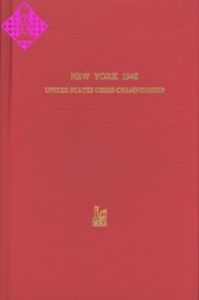Article Number
LXOWENUR1896
Author
Nuremberg 1896 - Int. Chess Tournament
403 pages, cloth-binding/ embossed in gold, Caissa Editions, 1999
Discontinued
What makes an international chess tournament great?
There are several prerequisites. First, there must be complete agreement about the rules of the game. At London in 1851, where it all began, the White pieces were not yet always associated with the first move; there was no complete agreement about stalemate. A second prerequisite was uniformity of tournament organization and regulation. In the beginning the contest was by elimination with pairings in each round to be de-termined by lot; the two strongest players in the tournament might meet in the first round!? There was no time limit. Then there were handicap tournaments among several classes of players; classes were determined by the opinions of the organizers. Finally, there was no lure except a prize fund; all of the participants had to pay their own traveling and living expenses - and in some cases even an entry fee!?
Change was inevitable. By 1862 in London sand glasses began to be used to allow each player twenty moves in two hours. At last a round-robin format was intro-duced, but draws were still con-sidered a problem and had to be replayed. (This was still a possible issue as late as 1902 at Monte Carlo.) And still wildly-foolish combinations of the elimination and round-robin formats were tried as late as 1906 at Ostend. But the format which produced the best games at a reasonable cost, within a reasonable time, without undue fatigue for the players, was a single-round round-robin which could be completed in about three weeks. Double-round round-robins with ten or twelve contestants were also reasonable, but "mammoth" tournaments like Vienna 1898, or even London 1899, were too long. By 1876 clocks began to replace sand glasses and beginning with London 1883 two clocks appeared in one unit.
The next prerequisite was the participation of the best players. But to stage an international tournament with foreign players traveling from great distances was very expensive. The next best idea was the national championship. The American Chess Congress tournaments, the first of which in 1857 made Paul Morphy famous, were held six times; only in 1889 did they begin to attract a number of reputable foreign entrants. British Chess Association tourna-ments began in 1862 and by 1890 foreign players were beginning to appear. German Chess Federation tournaments, which began in 1879, were the most important national events and they pushed Dr. Tarrasch, who won first prize in 1889, 1892, and 1894, to the forefront.
The desire to bring all of the great players together grew steadily and came to a head in 1894 when Steinitz lost his World Champion-ship title to the young Emanuel Lasker in a match which traveled from New York to Philadelphia and Montreal. The chess world could not believe that the old champion had not just had a stretch of bad luck. Surely a return match would restore him to his rightful place. This match was scheduled for Moscow in 1896.
In the meantime a big tournament with "everybody" in it seemed to be the answer. So was born Hastings 1895. Naturally the present and former World Champions would be invited together with the leading players of the leading chess-playing countries: England, Ger-many, Russia, France, and Aus-tria. The committee went one step too far, however, by inviting the Italian champion Vergani who was badly outclassed. They would have done better to include the young Hungarian Maroczy instead of just barely allowing him into the minor tournament. They guessed right, however, in including the young American Pillsbury, even though his recent record in Amer-ica was inferior to Showalter's. Pillsbury's stunning victory at Hastings was perhaps the greatest upset in chess history, marred only by his victory by forfeit over Bardeleben in the 17th round after the latter had made a great early run by winning six and drawing three of his first nine games, in-cluding a defeat of Lasker, before folding up and finishing outside of the prize list. The other blemish was Tarrasch's loss to Mason in the 1st round by overstepping the time limit when he had an over-whelming position. He had left his seat to stroll around the room assuming that he had made the requisite number of moves. (He had written his name on the line indicated for his first move!?) A strong run thereafter, including a win over Lasker, could earn him no better than 4th prize. Finally Lasker was somewhat indisposed during the early rounds, but nothing can be done about things like that.
The Hastings result, certainly the fruit of a great tournament, imme-diately suggested a "battle royal" among the five top prize winners to be held at St. Petersburg at the end of the year. Tarrasch used his medical practice as an excuse for not attending, but I suggest that he was not confident of the out-come and wished to avoid a con-frontation with Lasker at this time. The other four - Pillsbury, Tschigorin, Lasker, and Steinitz - did attend and had it not been for Pillsbury's tragedy* , the pecking order of great players might have assumed a different look.
Then came the next candidate for greatness. After the German Championship at Leipzig in 1894, (See The Match Tournament at St. Petersburg 1895-6, by John C. Owen. Caissa Editions 1989.) the committee of the Nuremberg Chess Club, of which Tarrasch was a member, had lobbied heavily to obtain the next championship in 1896. After St. Petersburg it seemed to Tarrasch that his home ground was a perfect setting for restoring him to chess supremacy, so the club set out to attract the best players available including the four contestants at St. Peters-burg. Interest was high and thirty-nine masters sent in their entries. Twenty were chosen, but at the last minute two of these Berthold Englisch, the veteran German Master, and Amos Burn, the English master had to with-draw. But to the remaining eight-een, in order that every player might enjoy a day off, the com-mittee, on the recommendation of Moroczy then entering his first master tournament, added the young Budapest player Rudolph Charousek, who, although he was not yet able to contend for a prize, certainly had his moments. Also among the contestants was the veteran Simon Winawer, who had submitted his entry at Hastings but had requested to be allowed to play under an assumed name!? His request was denied, but one wonders if he was being hounded by creditors and what disguise he would have assumed to avoid them!
Other additions to the field were the nominal U.S. Champion, Jack-son W. Showalter and two German veterans, Schallopp and Forges. Of the absent only Burn was missed. A tournament misfortune was Teichmann's illness which ruined his chances in the early rounds. While he scored only two points in the first 16 rounds, he doubled that score in the last three! There was one other tempo-rary fly in the ointment. Because of their great effort to make the championship tournament a suc-cess, the Nuremberg committee did not want to assume responsi-bility for holding the Hauptturnier and the other minor tournaments, which were customarily the ad-junct of the biennial champion-ships. This intramural squabble led to the angry departure of Max Lange and other leaders of the association to Eisenach, where they held a "rump" of minor tour-naments. Obviously there was no point to this sort of thing and two years later everyone was back together again at Cologne.
The Nuremberg Chess Club had planned well. Attendance would be boosted by the fact that the Bavarian State Exposition was being held at Nuremberg that summer. This made the work of the finance committee easier. Club members, leading citizens of Nur-emberg, and other chess clubs throughout Bavaria contributed generously. Finally the Museum Society of Nuremberg placed their facilities at the disposal of the tournament committee for use as the tournament site.
On Sunday, 19 July, 1896 at 10:OOAM the 19 contestants met at the site on the first floor at Königstrasse 1 for the formal greeting and the drawing of lots.
The first round began on Monday, 20 July at 9:OOAM. Play was from 9:OOAM until 1:OOPM and from 4:OOPM to conclusion. A one-hour rest was taken at 8:00PM, if nec-essary. The time limit was 30 moves in the first two hours and 15 moves in each succeeding hour - the same as at Hastings.
Admission tickets for the entire tournament were ten marks. Day tickets were one mark; tickets for one visit were 1/2 mark. The final banquet and prize giving was held on Sunday, 9 August. The first prize was 3,000 marks, the second prize 2,000 marks, the third 1,500 marks, fourth 1,000 marks, fifth 600 marks, sixth 300 marks, and seventh 200 marks. A special brilliancy prize of 300 marks was awarded to Harry Pillsbury for his win over Lasker. A special prize of 100 marks for the best score by a non-prize winner against the prize winners was awarded to Joseph Henry Blackburne.
Certainly all of the prerequisites for greatness had been met at Nuremberg, from the setting, the prizes, and the participation of the greatest players of the age. And by the end of 1896, especially after the one-sided return match for the World title at Moscow, it was clear that the one most important pre-requisite for greatness was the participation of Emanuel Lasker, who was the first master to domi-nate the chess world since Paul Morphy burst on the scene so briefly 40 years before. For many years there was no one to chal-lenge this view until Rubinstein, and later Capablanca, appeared. And Lasker continued to hold his own against the strongest players of the world for the next 40 years until he was 68!
There are several prerequisites. First, there must be complete agreement about the rules of the game. At London in 1851, where it all began, the White pieces were not yet always associated with the first move; there was no complete agreement about stalemate. A second prerequisite was uniformity of tournament organization and regulation. In the beginning the contest was by elimination with pairings in each round to be de-termined by lot; the two strongest players in the tournament might meet in the first round!? There was no time limit. Then there were handicap tournaments among several classes of players; classes were determined by the opinions of the organizers. Finally, there was no lure except a prize fund; all of the participants had to pay their own traveling and living expenses - and in some cases even an entry fee!?
Change was inevitable. By 1862 in London sand glasses began to be used to allow each player twenty moves in two hours. At last a round-robin format was intro-duced, but draws were still con-sidered a problem and had to be replayed. (This was still a possible issue as late as 1902 at Monte Carlo.) And still wildly-foolish combinations of the elimination and round-robin formats were tried as late as 1906 at Ostend. But the format which produced the best games at a reasonable cost, within a reasonable time, without undue fatigue for the players, was a single-round round-robin which could be completed in about three weeks. Double-round round-robins with ten or twelve contestants were also reasonable, but "mammoth" tournaments like Vienna 1898, or even London 1899, were too long. By 1876 clocks began to replace sand glasses and beginning with London 1883 two clocks appeared in one unit.
The next prerequisite was the participation of the best players. But to stage an international tournament with foreign players traveling from great distances was very expensive. The next best idea was the national championship. The American Chess Congress tournaments, the first of which in 1857 made Paul Morphy famous, were held six times; only in 1889 did they begin to attract a number of reputable foreign entrants. British Chess Association tourna-ments began in 1862 and by 1890 foreign players were beginning to appear. German Chess Federation tournaments, which began in 1879, were the most important national events and they pushed Dr. Tarrasch, who won first prize in 1889, 1892, and 1894, to the forefront.
The desire to bring all of the great players together grew steadily and came to a head in 1894 when Steinitz lost his World Champion-ship title to the young Emanuel Lasker in a match which traveled from New York to Philadelphia and Montreal. The chess world could not believe that the old champion had not just had a stretch of bad luck. Surely a return match would restore him to his rightful place. This match was scheduled for Moscow in 1896.
In the meantime a big tournament with "everybody" in it seemed to be the answer. So was born Hastings 1895. Naturally the present and former World Champions would be invited together with the leading players of the leading chess-playing countries: England, Ger-many, Russia, France, and Aus-tria. The committee went one step too far, however, by inviting the Italian champion Vergani who was badly outclassed. They would have done better to include the young Hungarian Maroczy instead of just barely allowing him into the minor tournament. They guessed right, however, in including the young American Pillsbury, even though his recent record in Amer-ica was inferior to Showalter's. Pillsbury's stunning victory at Hastings was perhaps the greatest upset in chess history, marred only by his victory by forfeit over Bardeleben in the 17th round after the latter had made a great early run by winning six and drawing three of his first nine games, in-cluding a defeat of Lasker, before folding up and finishing outside of the prize list. The other blemish was Tarrasch's loss to Mason in the 1st round by overstepping the time limit when he had an over-whelming position. He had left his seat to stroll around the room assuming that he had made the requisite number of moves. (He had written his name on the line indicated for his first move!?) A strong run thereafter, including a win over Lasker, could earn him no better than 4th prize. Finally Lasker was somewhat indisposed during the early rounds, but nothing can be done about things like that.
The Hastings result, certainly the fruit of a great tournament, imme-diately suggested a "battle royal" among the five top prize winners to be held at St. Petersburg at the end of the year. Tarrasch used his medical practice as an excuse for not attending, but I suggest that he was not confident of the out-come and wished to avoid a con-frontation with Lasker at this time. The other four - Pillsbury, Tschigorin, Lasker, and Steinitz - did attend and had it not been for Pillsbury's tragedy* , the pecking order of great players might have assumed a different look.
Then came the next candidate for greatness. After the German Championship at Leipzig in 1894, (See The Match Tournament at St. Petersburg 1895-6, by John C. Owen. Caissa Editions 1989.) the committee of the Nuremberg Chess Club, of which Tarrasch was a member, had lobbied heavily to obtain the next championship in 1896. After St. Petersburg it seemed to Tarrasch that his home ground was a perfect setting for restoring him to chess supremacy, so the club set out to attract the best players available including the four contestants at St. Peters-burg. Interest was high and thirty-nine masters sent in their entries. Twenty were chosen, but at the last minute two of these Berthold Englisch, the veteran German Master, and Amos Burn, the English master had to with-draw. But to the remaining eight-een, in order that every player might enjoy a day off, the com-mittee, on the recommendation of Moroczy then entering his first master tournament, added the young Budapest player Rudolph Charousek, who, although he was not yet able to contend for a prize, certainly had his moments. Also among the contestants was the veteran Simon Winawer, who had submitted his entry at Hastings but had requested to be allowed to play under an assumed name!? His request was denied, but one wonders if he was being hounded by creditors and what disguise he would have assumed to avoid them!
Other additions to the field were the nominal U.S. Champion, Jack-son W. Showalter and two German veterans, Schallopp and Forges. Of the absent only Burn was missed. A tournament misfortune was Teichmann's illness which ruined his chances in the early rounds. While he scored only two points in the first 16 rounds, he doubled that score in the last three! There was one other tempo-rary fly in the ointment. Because of their great effort to make the championship tournament a suc-cess, the Nuremberg committee did not want to assume responsi-bility for holding the Hauptturnier and the other minor tournaments, which were customarily the ad-junct of the biennial champion-ships. This intramural squabble led to the angry departure of Max Lange and other leaders of the association to Eisenach, where they held a "rump" of minor tour-naments. Obviously there was no point to this sort of thing and two years later everyone was back together again at Cologne.
The Nuremberg Chess Club had planned well. Attendance would be boosted by the fact that the Bavarian State Exposition was being held at Nuremberg that summer. This made the work of the finance committee easier. Club members, leading citizens of Nur-emberg, and other chess clubs throughout Bavaria contributed generously. Finally the Museum Society of Nuremberg placed their facilities at the disposal of the tournament committee for use as the tournament site.
On Sunday, 19 July, 1896 at 10:OOAM the 19 contestants met at the site on the first floor at Königstrasse 1 for the formal greeting and the drawing of lots.
The first round began on Monday, 20 July at 9:OOAM. Play was from 9:OOAM until 1:OOPM and from 4:OOPM to conclusion. A one-hour rest was taken at 8:00PM, if nec-essary. The time limit was 30 moves in the first two hours and 15 moves in each succeeding hour - the same as at Hastings.
Admission tickets for the entire tournament were ten marks. Day tickets were one mark; tickets for one visit were 1/2 mark. The final banquet and prize giving was held on Sunday, 9 August. The first prize was 3,000 marks, the second prize 2,000 marks, the third 1,500 marks, fourth 1,000 marks, fifth 600 marks, sixth 300 marks, and seventh 200 marks. A special brilliancy prize of 300 marks was awarded to Harry Pillsbury for his win over Lasker. A special prize of 100 marks for the best score by a non-prize winner against the prize winners was awarded to Joseph Henry Blackburne.
Certainly all of the prerequisites for greatness had been met at Nuremberg, from the setting, the prizes, and the participation of the greatest players of the age. And by the end of 1896, especially after the one-sided return match for the World title at Moscow, it was clear that the one most important pre-requisite for greatness was the participation of Emanuel Lasker, who was the first master to domi-nate the chess world since Paul Morphy burst on the scene so briefly 40 years before. For many years there was no one to chal-lenge this view until Rubinstein, and later Capablanca, appeared. And Lasker continued to hold his own against the strongest players of the world for the next 40 years until he was 68!
| EAN | 0939433540 |
|---|---|
| Weight | 750 g |
| Manufacturer | Caissa Editions |
| Width | 15.8 cm |
| Height | 23.5 cm |
| Medium | Book |
| Year of Publication | 1999 |
| Author | John C. Owen |
| Language | English |
| ISBN-10 | 0939433540 |
| Pages | 403 |
| Binding | cloth-binding/ embossed in gold |
| Name | Caissa Editions |
|---|---|
| Adresse | 721 Whitebriar Rd. Heckessin, DE 19707 USA |
| dbrandreth3@comcast.net |
Verantwortlicher Importeuer:
| Name | Schachversand Niggemann |
|---|---|
| Adresse | Schadowstraße 5 48163 Münster Deutschland |
| info@schachversand.de | |
| Internet | www.schachversand.de |
More from Caissa Editions

